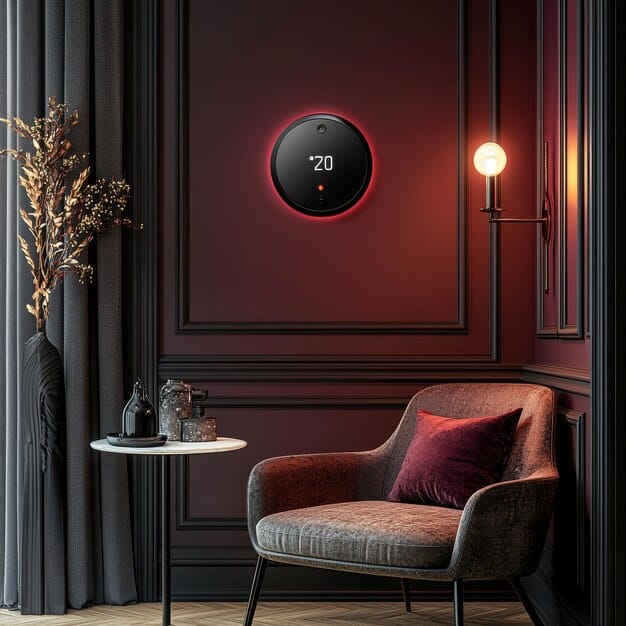Smart Thermostats: Save 15% on Your Energy Bill?

Smart thermostats can potentially help you save up to 15% on your energy bill by automating temperature adjustments, learning your preferences, and allowing remote control, contributing to reduced energy consumption and lower costs.
Are you tired of high energy bills? Do you wonder if smart thermostats can actually live up to the hype? The promise of a 15% reduction in energy costs is enticing, but does it hold true in real-world scenarios? Let’s delve into the world of smart thermostats: can they really save you 15% on your energy bill and explore how these devices work, their benefits, and whether they’re a worthwhile investment for your home.
Understanding Smart Thermostats
Smart thermostats are more than just replacements for traditional thermostats. They are sophisticated devices designed to optimize your home’s heating and cooling based on your habits and preferences.
They connect to your home’s Wi-Fi network, allowing you to control them remotely via a smartphone app or web interface. This connectivity opens up a world of possibilities for energy management and convenience.
How Smart Thermostats Work
At their core, smart thermostats use advanced algorithms and sensors to learn your heating and cooling patterns. They track when you’re home, when you’re asleep, and when you’re away, adjusting the temperature accordingly.
Many models also incorporate geofencing technology, which uses your smartphone’s location to detect when you’re approaching home and automatically adjust the temperature for your arrival.
Key Features of Smart Thermostats
- Remote Control: Adjust your thermostat from anywhere with an internet connection.
- Learning Capabilities: The thermostat learns your heating and cooling preferences over time.
- Geofencing: Automatically adjusts the temperature based on your location.
- Energy Reports: Provides insights into your energy usage patterns.
These features not only make it easier to manage your home’s temperature but also provide valuable data to help you understand and reduce your energy consumption. This enables you to make informed decisions that lead to savings on your bill while managing your energy consumption.
The Promise of 15% Energy Savings
The claim that smart thermostats can save you 15% on your energy bill is a common marketing point. But where does this number come from, and is it realistic?
Several studies and reports have investigated the energy-saving potential of smart thermostats. These studies often use a combination of real-world data and simulations to estimate the potential savings.

Understanding the Numbers
The 15% figure is often based on the assumption that a typical household wastes energy by heating or cooling an empty home. With a smart thermostat, these periods of inactivity can be automatically optimized.
However, the actual savings you experience can vary depending on a number of factors, including the size of your home, your climate, and your existing heating and cooling habits.
Factors Affecting Energy Savings
- Home Size: Larger homes may see greater savings due to more wasted energy.
- Climate: Homes in regions with extreme temperatures may have higher energy bills and therefore more potential for savings.
- Existing Habits: If you already diligently adjust your thermostat, the savings may be less significant.
Ultimately, the 15% figure should be seen as an estimate, and it’s important to manage your expectations based on your specific circumstances. By monitoring your energy habits it is possible to see real savings through better choices.
How to Maximize Energy Savings with Smart Thermostats
While smart thermostats offer the potential for significant energy savings, it’s important to use them effectively to achieve the best results.
Simply installing a smart thermostat isn’t enough. You need to understand how its features work and how to tailor them to your needs to see real reductions in your energy bill.
Setting Optimal Schedules
One of the most effective ways to save energy with a smart thermostat is to create a customized schedule. Identify the times when you’re typically away from home and set the thermostat to a more energy-efficient temperature during those periods.
You can also use the thermostat’s learning capabilities to fine-tune your schedule over time. As the thermostat learns your habits, it will automatically adjust the temperature to maximize savings.
Leveraging Geofencing
- Set up Geofencing: Define a geofence around your home to trigger automatic temperature adjustments.
- Test the Geofence: Ensure that the geofence is working correctly by monitoring the thermostat’s behavior when you leave and return home.
- Adjust Sensitivity: Fine-tune the geofence’s sensitivity to prevent false triggers.
By configuring geofencing correctly, you can ensure that your home is always at a comfortable temperature when you’re there, without wasting energy when you’re away. These features benefit many people who save money and time.

Potential Drawbacks and Considerations
While there are many advantages to smart thermostats, it’s important to be aware of potential drawbacks and considerations before making a purchase.
Smart thermostats are not without their limitations. Understanding these drawbacks can help you make an informed decision and avoid potential pitfalls.
Upfront Costs
Smart thermostats typically cost more than traditional thermostats. The upfront investment can be a barrier for some homeowners, especially those on a tight budget.
However, it’s important to consider the long-term savings that a smart thermostat can provide. Over time, the energy savings may offset the initial cost.
Compatibility Issues
- HVAC System Compatibility: Ensure that the smart thermostat is compatible with your existing heating and cooling system.
- Wiring Requirements: Some smart thermostats require specific wiring configurations.
- Voltage Compatibility: Check the voltage requirements to ensure compatibility with your home’s electrical system.
Before purchasing a smart thermostat, carefully review the compatibility requirements to avoid any installation issues. This is important for the thermostat to deliver a return on your investment and work as intended.
Smart Thermostats vs. Traditional Thermostats
Choosing between a smart thermostat and a traditional thermostat can be a confusing decision. To make an informed choice, it’s helpful to understand the key differences between the two.
Traditional thermostats are simple, reliable devices that allow you to manually set the temperature in your home. Smart thermostats, on the other hand, offer a range of advanced features and capabilities.
Key Differences
The primary difference between smart thermostats and traditional thermostats is the level of automation and control they offer. Smart thermostats can learn your habits, adjust the temperature automatically, and be controlled remotely.
Traditional thermostats require manual adjustments and offer limited energy-saving features.
When to Choose a Smart Thermostat
- Desire for Automation: If you want your thermostat to automatically adjust to your needs, a smart thermostat is a good choice.
- Connectivity: If you want to be able to control your thermostat remotely, a smart thermostat is essential.
- Energy Savings: If you’re looking to reduce your energy consumption and lower your bills, a smart thermostat can help.
If you value convenience, connectivity, and energy savings, a smart thermostat is likely the best choice for you. This is a good way to benefit from modern tech with a return on investment, as well.
Choosing the Right Smart Thermostat
With so many smart thermostats on the market, it can be challenging to choose the right one for your needs. Here are some factors to consider when making your decision.
The best smart thermostat for you will depend on your specific requirements, budget, and preferences. Comparing different models can help you find the perfect fit.
Compatibility
As mentioned earlier, compatibility is a crucial factor. Make sure that the smart thermostat you choose is compatible with your home’s heating and cooling system, as well as your existing wiring.
Check the manufacturer’s website or consult with a professional to ensure compatibility before making a purchase.
Features
- Learning Capabilities: Look for a thermostat that can learn your habits and adjust the temperature automatically.
- Geofencing: Consider a thermostat with geofencing capabilities for automatic temperature adjustments based on your location.
- Energy Reporting: Choose a thermostat that provides detailed energy usage reports.
Think about which features are most important to you and choose a thermostat that offers them. A deeper understanding of your needs as well as the thermostats abilities leads to better satisfaction.
| Key Point | Brief Description |
|---|---|
| 💡 Energy Savings | Smart thermostats can reduce energy bills by automating temperature adjustments. |
| 📱 Remote Control | Control your thermostat from anywhere using a smartphone app. |
| 🌡️ Smart Learning | Thermostats learn your preferences to optimize energy usage. |
| 📍 Geofencing | Adjusts temperature based on your location, saving energy when you’re away. |
Frequently Asked Questions
▼
Yes, they can. By automating temperature adjustments and learning your habits, smart thermostats reduce energy waste. The actual savings depend on factors like home size and climate.
▼
Many smart thermostats are designed for easy DIY installation. However, if you’re not comfortable working with electrical wiring, it’s best to hire a professional installer.
▼
Most smart thermostats are compatible with a wide range of HVAC systems, but it’s important to check compatibility before purchasing. Some systems may require additional adapters.
▼
Geofencing uses your smartphone’s location to create a virtual boundary around your home. When you leave the boundary, the thermostat adjusts the temperature to save energy.
▼
Even without an internet connection, most smart thermostats will continue to function as a regular thermostat. You can still manually adjust the temperature until the connection is restored.
Conclusion
In conclusion, smart thermostats: can they really save you 15% on your energy bill is a question with a nuanced answer. While the potential for savings is real, the actual amount depends on various factors. By understanding how these devices work and using them effectively, you can maximize your energy savings and enjoy a more comfortable, efficient home. Always consider your home, your HVAC system, and your behavior when determining compatibility and overall effectiveness.





